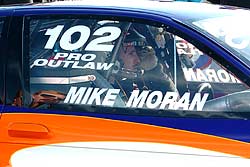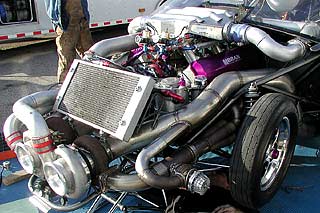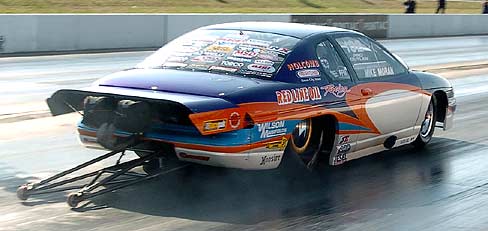![]() f you were to look at a list
of "who's who" in street car racing, you'd find the name Mike Moran near the
top of the list. Even before the likes of Tony Christian and Pat Musi took to
the street car scene, you could find Mike either tuning or driving a hot rod.
To his credit are several Top 10 fastest street car jackets and in 1996 he took
the top honors in "Casper" as the "world's fastest street car", a car which
forever changed the scene of street car racing as we know it.
f you were to look at a list
of "who's who" in street car racing, you'd find the name Mike Moran near the
top of the list. Even before the likes of Tony Christian and Pat Musi took to
the street car scene, you could find Mike either tuning or driving a hot rod.
To his credit are several Top 10 fastest street car jackets and in 1996 he took
the top honors in "Casper" as the "world's fastest street car", a car which
forever changed the scene of street car racing as we know it.

Fast forward to 2003 and another car emerged from the Moran racing stable promising not only to change the face of street car racing but have a dramatic impact on doorslammer racing all over the world.
Could Mike Moran be the Buddy Ingersol of Pro Modified? [Editor's note: Ingersol ran a twin-turbo Buick in IHRA and was banned from Pro Mod and Pro Stock competition. He ended up running outlaw.] While that remains to be seen, it's evident that, although Moran hasn't been on the track the last few years with the exception of the Orlando World Street Nationals, he has continued to be a force. He still builds the laughing gas motors for some record holding entries in the street car series such as Dale Pittman and Rob Globo, as well as providing turbo power for Greg Blevins and a host of others.
Mike has always been a fan of technology. Hooking up with longtime friend John Meaney (one of the pioneers of high performance fuel injection systems) is proving to be a lethal combination as the twin turbocharged powerplant in his Monte Carlo makes over 3300 hp and 2600 ft/lbs of torque.

Many people remember that Moran tried his hand at a quad turbo big block Chevy a few years back in Orlando. Since the combination was already banned by the street car sanctioning bodies, he didn't pursue that technology to optimize the combination but instead turned his efforts to building a new combination.
The 1999 Monte Carlo started life as an IHRA legal Pro Stock entry. Gordon Sprosek and Bart Lemiux purchased the car and, since Moran and Lemiux operate out of the same shop, the three combined forces to form MSL racing and started transforming this mid six-second performer into what eventually aspires to be a five-second doorslammer. The chassis was sent back to the original fabricator, Larry Larson of Larson Race Cars (Oak Grove, MO) for a full update and to install double frame rails to help transfer the brutal torque the monster powerplant can deliver to the ground.
 The
motor was put together using mostly existing parts which is how the 540 c.i.
displacement was derived. The motor uses JE Pistons connected to GRP connecting
rods. Air is forced through the motor with two Precision Turbo 91mm turbos and
is moved efficiently through the motor courtesy of CFE/Moran heads topped with
a Jesel valvetrain. Flatout gaskets keep the motor sealed tight and spark is
provided via MSD 10 ignition system and controlled with a FAST (Fuel Air Spark
Technology) EFI management system. Redline Oil keeps the motor well lubricated
and Torco 118 octane fuel is burned, with the resulting exhaust gases routed
out via Flowmaster Mufflers. A Racepack V500 system provides the team with loads
of data from each pass and is analyzed to make adjustments.
The
motor was put together using mostly existing parts which is how the 540 c.i.
displacement was derived. The motor uses JE Pistons connected to GRP connecting
rods. Air is forced through the motor with two Precision Turbo 91mm turbos and
is moved efficiently through the motor courtesy of CFE/Moran heads topped with
a Jesel valvetrain. Flatout gaskets keep the motor sealed tight and spark is
provided via MSD 10 ignition system and controlled with a FAST (Fuel Air Spark
Technology) EFI management system. Redline Oil keeps the motor well lubricated
and Torco 118 octane fuel is burned, with the resulting exhaust gases routed
out via Flowmaster Mufflers. A Racepack V500 system provides the team with loads
of data from each pass and is analyzed to make adjustments.
Mike says the car has many unique pieces that make it different and he doesn't go with the "norm" that everyone else uses. He credits his Liberty's Gears transmission with at least a three mile per hour gain over anything else he's used, which might help explain the incredible mph this car runs. The car uses the intercooler out of the late Steve Grebeck's Mustang, which was donated by Harry Hruska from Precision Turbo, so a part of Steve Grebeck always is along for the ride.
|
|
After the Orlando World Nationals in 2003 where the car shook the tires so severely that it launched the wheel tub through the rear window, the team was determined to solve their problems. They tested in Norwalk, OH and finally had success making three complete passes down the track (the quickest being 6.39 at 233), but with a very soft tune-up and slipping the clutch to the point it was severely wounded each pass.
Over the winter, Mike and team put the car on a severe diet, replacing everything they could with carbon fiber and titanium pieces. He said the savings alone in titanium is at least 170 lbs. One thing "weighing" on the minds of everyone is just that -- how much does it weigh?
"I weighed it in front of a crowd of people in Virginia and it weighed 2520 pounds with me in it," Moran said. "All these people that are saying I was at weight are full of it, they need to quit crying and realize I was light. When I put the weight back in the car I think it can run 6.50's and 6.60's, which is in line with what the other guys are running.
"The guys in the Street car sanctioning bodies don't want any part of it, though, as they've already threatened to load up and go home if I pull in," he added.
The team loaded up and left the cold of Michigan behind to head for killer air of Houston, TX in February to the Pro Stock SuperBowl. Attempts to hook the power broke the drivetrain three times and forced the team to load up and regroup. Moran came back to Darlington for the Winternationals where the first hit broke the drivetrain again -- at which time he decided another approach was needed. After several conversations with Warren Johnson, Jeff Stange at Strange Engineering, and many other driveline gurus, they all thought Moran might be a few aces shy of a full deck since no one had ever broken a 1350 U-Joint which is designed to handle 4300 ft/lbs of torque without shearing.
This caused Moran to second-guess himself but then a "light" went off that while the motor isn't making over 4300 ft/lbs of torque, if you combine that with the multiplier of the transmission, it is well over the limit.
Jeff Stange and Tom Reider (Precision Gear) worked closely to develop a more robust pinion, transmission yoke and new U-joint technology. Reider also made special 9.5-inch rear gears for the turbo missile.
Moran says they're just blazing a trail into uncharted territory and believes eventually all the Pro Modified competitors will need this technology. Also unique to this combination is the 36-inch developmental Hoosier tires trying to apply the ungodly torque of this animal to the ground. Moran's first run in Virginia didn't quite get him the e.t. he was looking for (only a 6.97, shutting off early) but it did tell him that the drivetrain appeared to be able to stand up to the power. The next run out, the team threw everything at it and shook the tires and had to shut down.
Later Thursday night as the staging lanes were closed, Moran and crew rolled into the water box for one last attempt that day. With the air 250-feet below sea level and the track temperature optimum, Mike fired "the shot heard around the world" as he ran an incredible 6.26 at 239.70 mph. His incrementals were 1.06, 2.83, and 4.19 at 184.
Proving it wasn't a fluke, he came back on Friday night in very similar conditions and backed it up with an equally impressive 6.25/236.84 with incrementals of 1.05, 2.83, and 4.18 at 185.

So where does he go from here? As Moran said, "Mile per hour doesn't mean anything, I want to run 5.90's." He wants to make some outlaw Pro Mod races but feels like even though he's two-tenths off where he wants to be, these runs have already put the fear in other competitors that say they don't even want to race against him. Since the car is making all the numbers on the back half of the track, the team has their work cut out for them and they're going to start working on the front half incrementals. Moran admits he isn't against the use of alternative fuels or other power-adders to get to that five-second time-slip if that's what it takes.
With some talk in the pits already about boycotting racing against him, if you don't see him anywhere else, Mike plans to field the car in Orlando for the this year's World Street Nationals October 15-17.
Behind the scenes, the crew consisting of Bart Lemiux, Larry Larson (who Moran states has helped immensely with the chassis and clutch calls), Matt Trett, Mike Vincowski, Eric Coleman and Matt Grawberg keep the Red Line Oil-sponsored Monte Carlo in race ready condition.
Moran wants to see turbos legal in Pro Modified although it will be up to IHRA Tech Director Mike Baker to make that call. From conversations between Moran and Baker, Moran thinks it is a future possibility although admittedly Baker's plate is overloaded now and it would take a lot of time to figure out a reasonable set of rules to play by. So, it would appear this project is on the "back burner" for now.
In the end, Moran and team are rolling up their sleeves and still working and doing R&D in the quest for lower e.t.'s and faster speeds and that five-second time-slip.
Copyright 1999-2004, Drag Racing Online and Racing Net Source